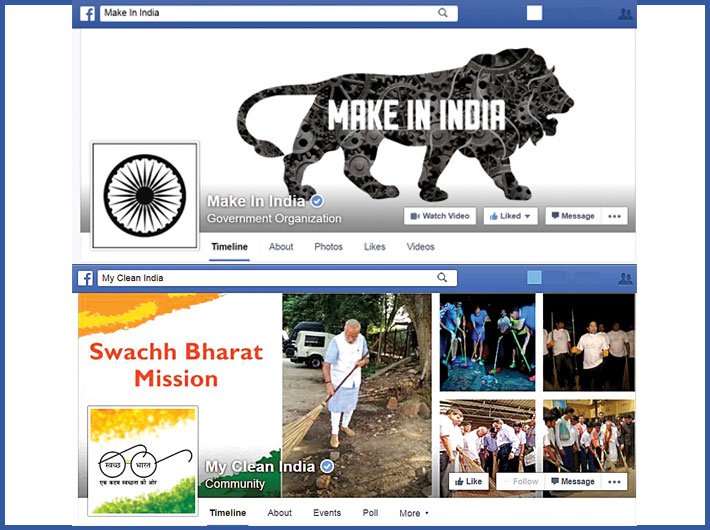For transformational citizen-facing programmes to be as effective as political campaigns, social media strategies must be top-notch
Isn’t it a bit ironic that while social media has been harnessed increasingly for achieving political changes, it has yielded little result when it comes to delivering social changes? In that sense, social media has so far been something of an oxymoron.
Peoples’ engagement with social media also are inclined more on the political fronts than on the social fronts. Even as citizens our social media activities are limited. The fervour with which people tend to support or oppose a leader’s political statements easily dwarfs their responses to the social-facing appeals from that very leader.
Is that because political strategists have a better understanding of social media than the social strategists?
Social activist Anna Hazare’s page on Twitter has mere 13.4 thousand followers, while his disciples who took the political route have several times larger fan bases. For instance, Kiran Bedi’s Twitter page had 3.84 million followers at the time of writing this article while Arvind Kejriwal’s page showed 3.44 million followers.
Is it that people are less sensitive to the social events even if those directly relate with their lives? Is it that they prefer to get swayed by political waves that mostly have only fleeting impacts on their routines?
Why does it take a Nirbhaya incident for the populace to take to streets in solidarity (and then develop apathy to the underlying social evil of rape thereafter), whereas political rallies easily continue to evoke much bigger turnouts at any given time of a year?
Several election results at various legislative levels have proven over time that people are politically mature. But, at the same time, the rising incidence of social evils keeps demonstrating that we also suffer from deficits when it comes to social maturity.
Could social media help?
Recently, politicians and their campaign teams have successfully harnessed the power of social media and networks to work magic in their favour (and against their opponents). Specifically, social media campaigns have been at the very core of the massive political change brought about in the two largest democracies - India and USA.
Now, can the same social media channels be leveraged to create social movements of comparable scales, in order to bring about transformative social changes? For example, could the ‘swachh bharat abhiyan’ be turned into an actual ground-level movement that could bring about a transformational change in citizens’ approach towards cleanliness?
Ironic though it may be, a fact remains that any success for such citizen-facing programmes has to begin with the political endorsement or patronage it receives. It is notable that only after the prime minister stepped out in the support of the cleanliness drive did it pick up momentum and even started trending on the social media.
What can government agencies do to ensure that such citizen-facing programmes don’t fade away from public memory after trending as hashtags on social media channels for a while?
While endorsements for citizen-facing programmes from political leaders can actually be a good way to begin with, there certainly needs to be a follow-up mechanism in place to take the baton forward. Also, unlike in the case of a political event such as a rally or even an election that could be fed through week- or month-long campaigns, a citizen-facing programme would need a long life.
Role of the governments
After a well-intending political celebrity has done her/his bit in terms of building up an initial momentum for a citizen-facing programme, it is ultimately a well-planned thrust from the government machinery that could make the message perpetuate and permeate across multiple layers of geographies, societies and times.
What things should government bodies bear in mind while designing campaigns for citizen-facing programmes and missions?
Historically and characteristically, government agencies have been accustomed to using the broadcast mode for government-to-citizen (G2C) communications. While that was acceptable in the era of print, audiovisual and even web 1.0 media, the onset of social media called for a paradigm shift.
Today, with the presence of citizens on social media reaching swelling proportions (with a reportedly 112 million Facebook users in India), governments have the opportunity to actively involve citizens as programme evangelists and champions. Moreover, listening - specifically targeted listening - of citizen voices across diverse social media channels, has got to be a fundamentally important part of the campaign.
A well architected, structured listening programme could yield a goldmine of citizen-to-government (C2G) big data, which could be used for precious citizen insights gathered from sentiment analysis. The insights could be used to develop the right sets of social relationship management (SRM) strategies by various government agencies.
Moreover, the length of a campaign like ‘swachh bharat abhiyan’ cannot be short-term. A social media campaign for the mission would rather need to run for months, if not years, in a row.
This is also where a citizen-facing campaign starts strategically differing from a leader’s political drive on social media. A political campaign would have relatively short-term goals and therefore could be designed to peak quickly and then fade away. On the other hand, a citizen-facing campaign with a social transformation objective would probably not ever require to peak but need to be reinforced at regular intervals to stay steady and sustainable.
Enterprise-grade or politics-grade?
These are still early days for governments when it comes to making use of social media to build meaningful to-and-fro dialogues with citizens so as to improve the efficacy of various G2C programmes.
As such, stakeholders in governments would benefit from inculcating some of the best practises employed by the social media cells of the political parties. Further, large enterprises, which are comparable in size to many a government and civic bodies and departments, could be rich reference points for such best practises.
One of the aspects that both the political outfits and the enterprises focus a lot upon is reputation building. When compared to enterprises, political outfits also lay a relatively much higher emphasis on growing their followers’ base.
When it comes to citizen-facing programmes, both the factors are more or less equally important. While a large follower base also helps increase the reach of the messaging, a positive reputation leads to increased levels of trust and more active support from the target audience among the citizens.
Moreover, social media feedback and sentiment analysis could also be used to refine the programme delivery and measure the impacts in a more transparent and accountable manner.
On the lines of social media cells deployed by political parties, the campaign delivery and monitoring units could be set up by the government agencies as well. In fact, as far as the scale of social media engagements of these agencies goes, over a period of time it would be much bigger than what enterprises would achieve and more comparable with what political parties have attained.
However, when it comes to the level of sophistication that governments’ SRM strategy would need to achieve, the benchmark would more appropriately be drawn from what enterprises are doing or planning.
(The article appeared in February 16-28, 2015, issue)

